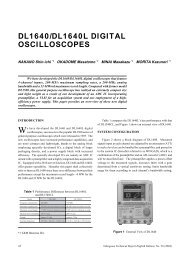2017-8-1_stip_final-508ed
You also want an ePaper? Increase the reach of your titles
YUMPU automatically turns print PDFs into web optimized ePapers that Google loves.
NASA Strategic Technology Investment Plan<br />
many iterations and require longer development time. Solutions addressing these needs are<br />
generally high risk but equally high return. They are often less mature and represent unique<br />
alternatives over current solutions. These technologies also generally have potential for a very<br />
high impact on cost, safety, or reliability.<br />
The STIP also identifies ancillary technologies that provide incremental performance<br />
improvements to existing technologies and are required to support Critical and Enhancing<br />
developments. Although individual ancillary technologies are invested in as needed throughout<br />
the portfolio, they do not require assessment from a strategic perspective.<br />
The investment categorization in the STIP ensures NASA is prioritizing the technologies needed<br />
for planned, near-term scientific discovery, human exploration, and aeronautics missions, while<br />
developing technologies that will be fundamental to its future missions.<br />
Critical Technology Investments<br />
NASA has identified ten broad investment areas containing Critical technologies. These areas<br />
group the Critical technologies from one or more of the 2015 NASA Technology Roadmap<br />
areas. Critical technologies identified in the 2015 NASA Technology Roadmaps are generally<br />
cross-cutting, meet more than one mission-specific need, and provide significant risk reduction.<br />
Critical technologies also include aeronautics research thrusts. NASA’s investment in Critical<br />
technologies will comprise approximately 70 percent of the Agency’s technology development<br />
portfolio. These technologies have a crucial enabling role for NASA’s scientific, robotic, and<br />
human exploration missions. The ten Critical technology investment areas are:<br />
1. Propulsion and Launch Systems<br />
2. Human Health, Life Support, and Habitation<br />
3. Destination Systems<br />
4. Robotics and Autonomous Systems<br />
5. Scientific Instruments, Sensors, and Optical Communications<br />
6. Lightweight Space Structures and Materials<br />
7. Entry, Descent, and Landing<br />
8. Space Power Systems<br />
9. Advanced Information Systems<br />
10. Aeronautics<br />
Technologies within these areas were identified by the STIP Leadership<br />
Team as Critical to implementing NASA’s investment strategy. Each of<br />
the critical technologies in the STIP are characterized as either near or<br />
mid-term, based on the needed timing of initial investments. Near-term<br />
Critical technologies require investments in the technology starting now<br />
(or continuing current investments) in order to fulfill requirements for<br />
planned and projected missions. In contrast, mid-term Critical<br />
technologies can delay their investment start dates three years or more<br />
from today. Related technologies that potentially represent additional<br />
investments could be considered for future efforts. The following sections<br />
highlight technical challenges and NASA’s approach to solving these<br />
challenges in addition to impacts to NASA and the Nation related to<br />
these technologies. The primary source for technical information within<br />
this section was NASA’s 2015 Technology Roadmaps with additional<br />
information retrieved from the Agency’s technology database, TechPort,<br />
and provided by the Mission Directorates.<br />
Figure 6: 10 areas within the<br />
Critical technology category.<br />
8







